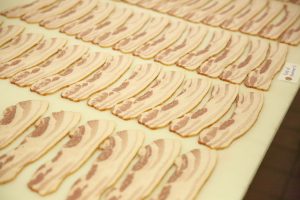This story also appears in our University of Missouri College of Agriculture, Food and Natural Resources’ Agricultural Research Center Magazine. Stop by your local Research Center to pick up a copy! You can view the magazine online by clicking here: Road to Discovery.
Katelyn Burdick was on the hunt for a graduate project two years ago after earning her bachelor’s degree from the Division of Animal Sciences – and Professor Bryon Wiegand had a perfect venture.
Wiegand was interested to know if the inclusion of tree nuts in a pig’s finishing diet would affect the fatty acid composition and the overall processed meat products. The process of feeding tree nuts to pigs is a more common practice in Spain and Portugal where they produce world-famous Iberian ham, and Wiegand wanted to see what difference, if any, the diet would produce compared to a traditional diet fed in the United States. Burdick liked the project idea, which included an added bonus. In addition to the research, Burdick would serve as the coach for the University of Missouri meat judging team.

“I had never heard of feeding tree nuts to pigs,” Burdick said. “I was really intrigued by the entire process. I had also been a part of the Mizzou meat judging team, so being able to coach the team was an exciting opportunity.”
Burdick spent the first half of her graduate work focusing on coaching the meat judging team. She received 30 Duroc/Duroc crossbred barrows from Kevin Duncan, an advisor for the Columbia FFA chapter, and officially began her research in October 2018.
“These were weaned pigs,” Burdick said. “We raised them through their grower phase until the finishing phase, which is when we began their new diet with the tree nuts.”
Burdick said they fed the tree-nut diet for the last 28 days before slaughter. Burdick received around 750 pounds of chestnuts and around 750 pounds of acorns from the MU Center for Agroforestry through its chestnut and oak research orchards, located at the Horticulture and Agroforestry Research Center, in New Franklin, for the project.
“The chestnuts and acorns were sorted, and a proximate analysis was conducted on the tree nuts,” Burdick said. “We did a complete feed analysis, where we determined the fat, moisture and protein of each nut. We analyzed the tree nuts so we could formulate the correct diet and meet the National Research Council (NRC) requirements for our pigs.”
The chestnuts and acorns were then taken to the feed mill.
“The acorns hammermilled just fine,” Burdick said. “We had some problems with the chestnuts early on. They basically became gum when hammermilled. We had to figure out the best way to turn those chestnuts to feed. We ended up drying each chestnut in a large drying oven. We dried them for a day, cracked all of them and dried them for two more days. They were perfect after that.”
Burdick said that the pigs constantly had feed and water in front of them. She added that the pigs seemed to really enjoy the feed. Each pig had its own pen, feeder and water. They were all housed at the Swine Teaching Facility at the South Farm Research Center, in Columbia.
“I was constantly having to refill their feeders,” Burdick said. “It was really interesting. The chestnuts had a sweet smell, so it will be interesting to see any differences between the treatment diets. They definitely loved it.”
After slaughter, the hams were further processed into prosciutto at Volpi Foods (St. Louis) and the bellies were processed into bacon slabs at Paradise Meat Locker (Trimble). They took five fat deposits from the carcasses as well, to analyze for fatty acid composition.

“It was interesting to see a significant change in the fatty acid profile between the tree nut diets,” Burdick said. “Additionally, barrows fed a chestnut diet displayed a more efficient gain to feed ratio. Inclusion of acorns and chestnuts did not negatively impact carcass characteristics, carcass quality or bacon quality.”
Burdick will graduate with her master’s degree in May. She originally came to MU with the goal of becoming a veterinarian. She decided that path wasn’t the correct one after a handful of years working at the Foremost Dairy Research Center, near Columbia. She gained experience in animal production through that opportunity.
“I didn’t grow up on a farm, so I had a lot to learn,” Burdick said. “(Farm Manager) John (Denbigh) taught me everything I know about dairy and farm work in general. Students gain the experience in feeding and milking the cows, as well as operating expensive farm equipment. Additionally, students are responsible for the daily care of the herd, such as postpartum checks and vaccinations.
“Working at a research facility is incredibly valuable. What I learned in class, I was seeing in action. I’m a visual person. Going to the farm and doing the actual work is so beneficial for me. Learning in the classroom is vital, but being able to apply it in the field is amazing. I hope our undergraduates take advantage of the various Research Centers we have throughout the state.”
Burdick grew up in Lee’s Summit and attended Blue Springs South High School, where she got involved in the National FFA Organization. She was on numerous teams while part of the organization, and later joined the meats team at Mizzou.
“I had a friend on the team when I came to MU, and they thought I would really enjoy the team,” Burdick said. “I have enjoyed my time as a meats judger and coach. My master’s work has been perfect. Having the opportunity to coach the meats team – and do important research – has been incredible.”